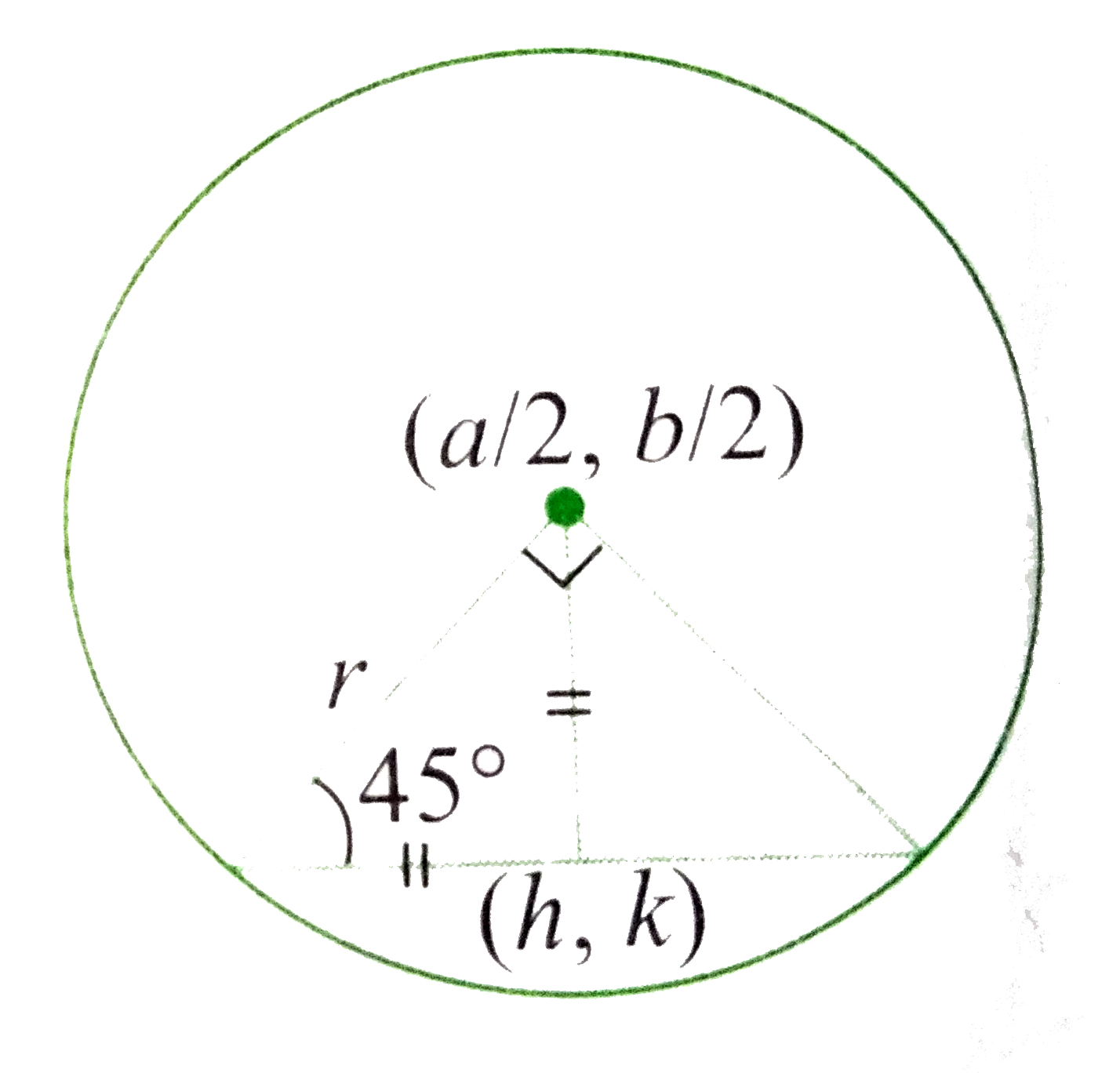The locus of the midpoints of the chords of the circle x2+y2−ax−by=0 which subtend a right angle at (a2,b2) is (a)ax+by=0 (b) ax+by=a2+b2 (c) x2+y2−ax−by+a2+b28=0 (d) x2+y2−ax−by−a2+b28=0Solution in Bengali
ax+by=0
ax+by=a2=b2
x2+y2−ax−by+a2+b28=0
x2+y2−ax−by−a2+b28=0
The correct Answer is:3
r=√a24+b24=√a2+b22
sin45∘=√(h−a2)2+(h−b2)2√a2+b2/2
or 12=4⎡⎢
⎢⎣(2h−a)24+(2k−b)24a2+b2⎤⎥
⎥⎦
Simplify to get locus x2+y2−ax−by−a2+b28=0

Topper's Solved these Questions
- BOOK - CENGAGE PUBLICATIONCHAPTER - CIRCLE EXERCISE - Multiple Correct Anser Type29videos
CIRCLE
- BOOK - CENGAGE PUBLICATIONCHAPTER - CIRCLE EXERCISE - Linked Comprehension Type (For Problem 1-3)3videos
CIRCLE
- BOOK - CENGAGE PUBLICATIONCHAPTER - CIRCLE EXERCISE - CONCEPT APPLICATION EXERCISE 4.172videos
CIRCLE
- BOOK - CENGAGE PUBLICATIONCHAPTER - BINOMIAL THEOREMEXERCISE - Comprehension11videos
BINOMIAL THEOREM
- BOOK - CENGAGE PUBLICATIONCHAPTER - CIRCLESEXERCISE - Comprehension Type8videos
CIRCLES
Similar Questions
about to only mathematics
02:05View SolutionEach side of a square is of length 6 units and the centre of the square Is ( - 1, 2). One of its diagonals is parallel to x+y=0. Find the co-ordinates of the vertices of the square.
01:40View SolutionThree concentric circles of which the biggest is x2+y2=1, have their radii in A.P If the line y=x+1 cuts all the circles in real and distinct points. The interval in which the common difference of the A.P will lie is:
03:41View SolutionConsider a G.P. with first term (1+x)n, |x|<1, common ratio 1+x2 and number of terms (n+1). Let 'S' be sum of all the terms of the G.P., then
The coefficient of xn is 'S' is02:12View Solution
In the diagram as shown, a circle is drawn with centre C(1,1) and radius 1 and a line L. The line L is tangent to the circle at Q. Further L meets the y-axis at R and the x-axis at P in such a way that the angle OPQ equals θ where 0<θ<π2.
Coordinate of Q is03:56View SolutionIf the origin is shifted to the point (aba−b,0) without rotation, then the equation (a−b)(x2+y2)−2abx=0 becomes (A)(a−b)(x2+y2)−(a+b)xy+abx=a2 (B)(a+b)(x2+y2)=2ab (C)(x2+y2)=(a2+b2) (D)(a−b)2(x2+y2)=a2b2
03:13View Solution(x)/(a)+(y)/(b)=a+b(x)/(a^(2))+(y)/(b^(2))=2,a!=0,b!=0
02:41View Solutiona2x−b2y=0a2bx+b2ay=a + b, where x, y≠0.
03:32View SolutionSolve the following pair of equations for x and y :
a2x−b2y=0,a2bx+b2ay=a+b,
x≠0,y≠0.03:44View SolutionThe image of the pair of lines represented by ax2+2hxy+by2=0 by the line mirror y=0 is ax2−2hxy−by2=0 bx2−2hxy+ay2=0 bx2+2hxy+ay2=0 ax2−2hxy+by2=0
02:31View SolutionIf the origin is shifted to the point (aba−b,0) without rotation, then the equation (a−b)(x2+y2)−2abx=0 becomes
03:33View SolutionThe image of the pair of lines represented by ax2+2hxy+by2=0 by the line mirror y=0 is ax2−2hxy−by2=0 bx2−2hxy+ay2=0 bx2+2hxy+ay2=0 ax2−2hxy+by2=0
02:09View SolutionThe locus of the midpoints of the chords of the circle x2+y2−ax−by=0 which subtend a right angle at (a2,b2) is (a)ax+by=0 (b) ax+by=a2+b2 (c) x2+y2−ax−by+a2+b28=0 (d) x2+y2−ax−by−a2+b28=0
03:45View SolutionSolve : a(x+y)+b(x−y)=a2−ab+b2, a(x+y)−b(x−y)=a2+ab−b2
01:35View SolutionEquation of the circle through origin which cuts intercepts of length a and b on axes is a. x2+y2=ax+by=0 b. x2+y2−ax−by=0 c. x2+y2+bx+ay=0 d. none of these
03:51View SolutionFactorize: ax+bx+ay+by, ax2+by2+bx2+ay2, a2+bc+ab+ac, ax−ay+bx−by
03:11View Solution

